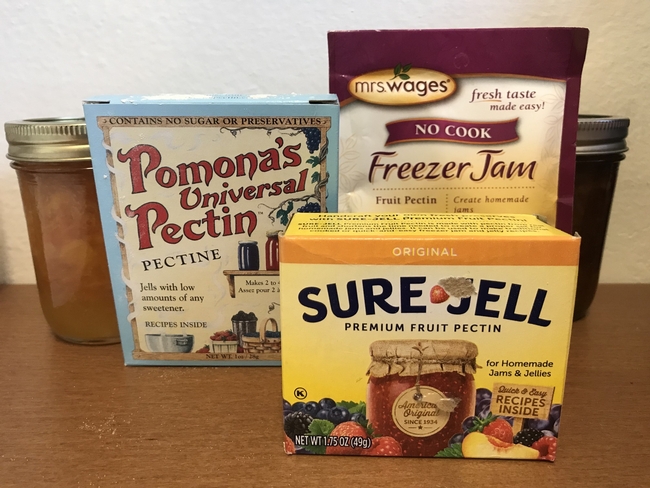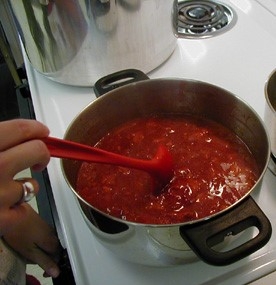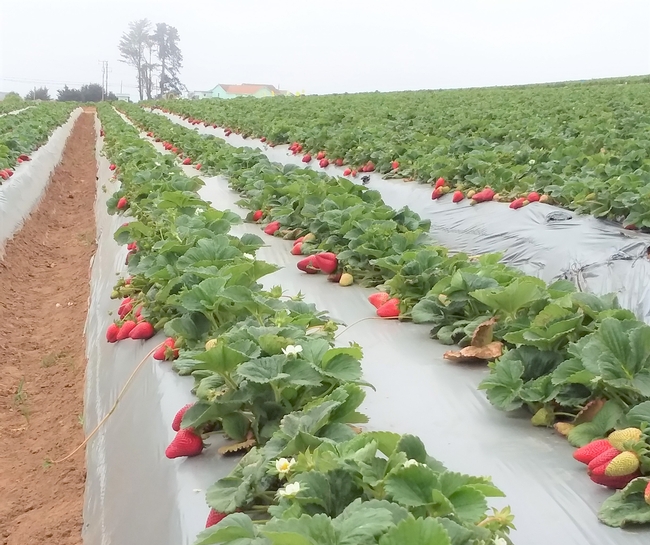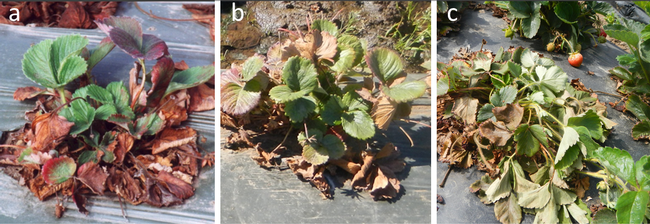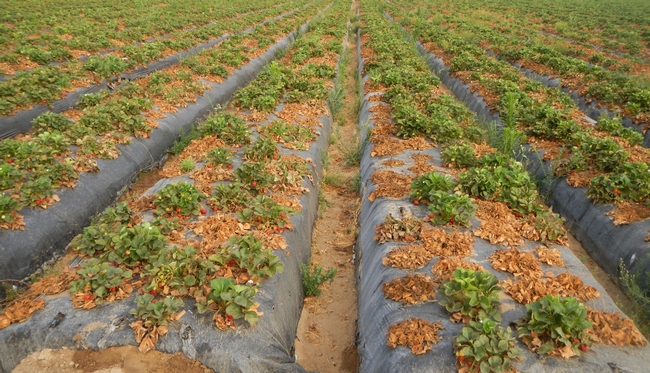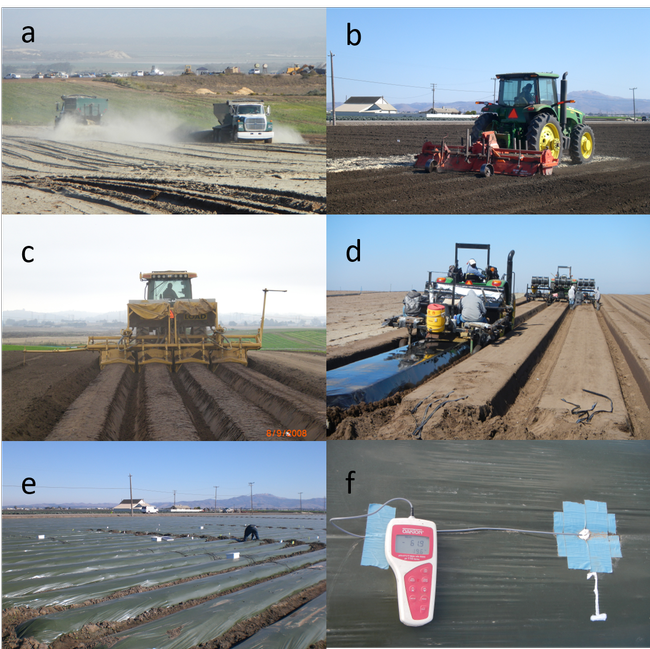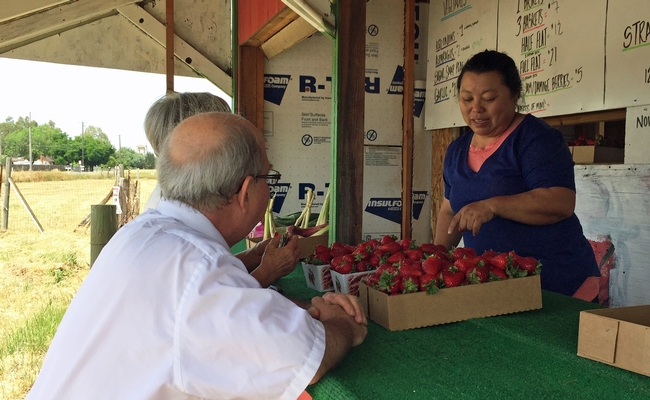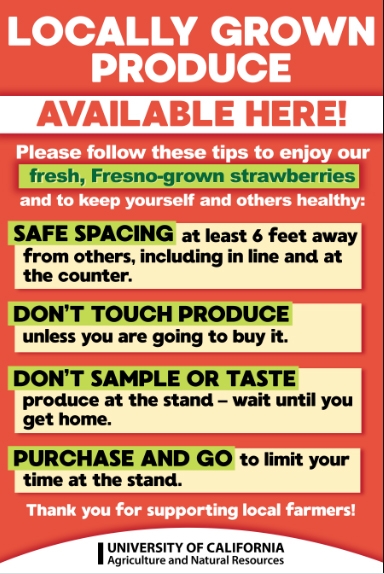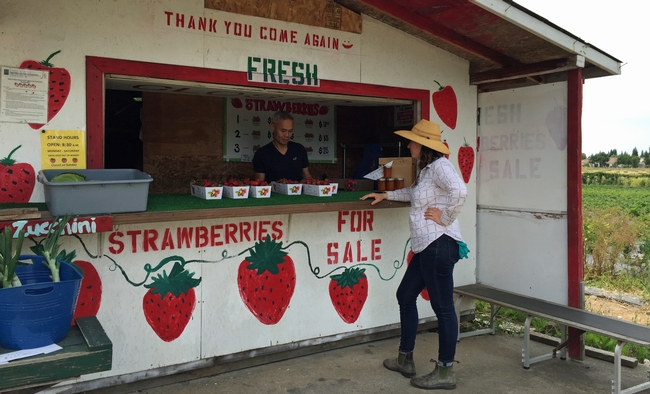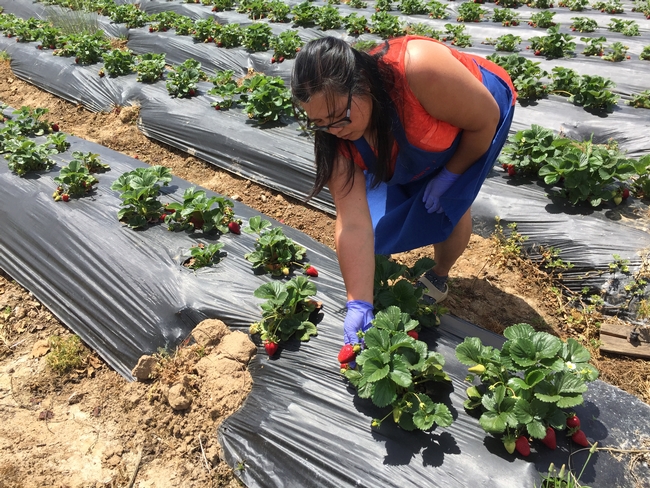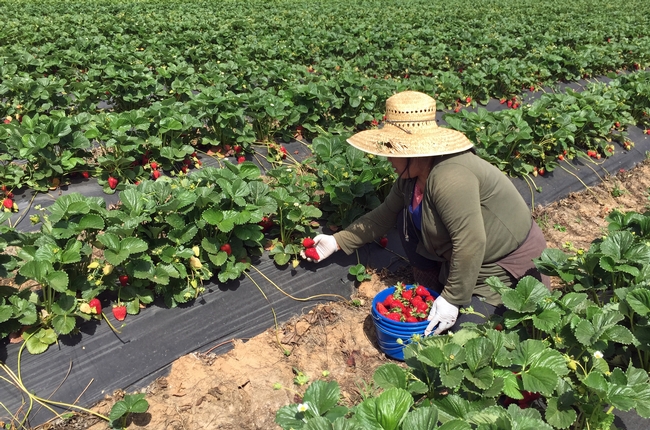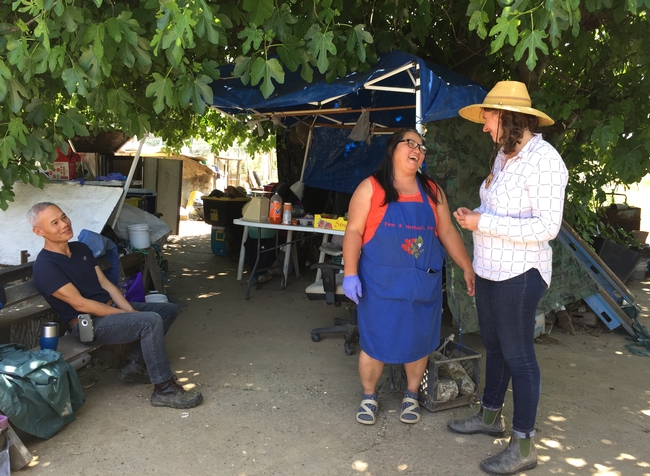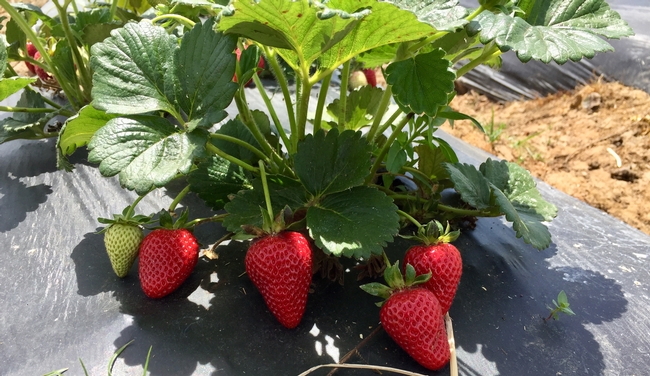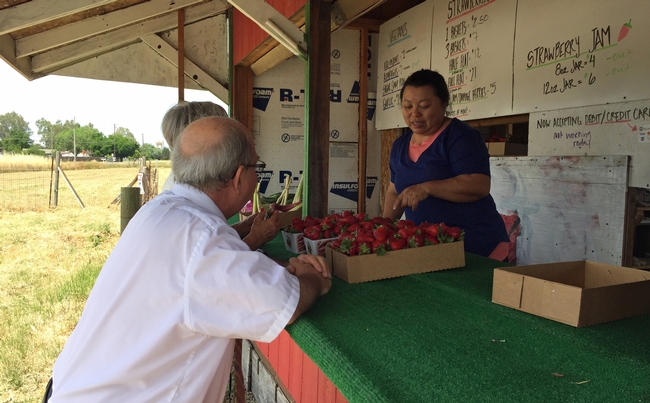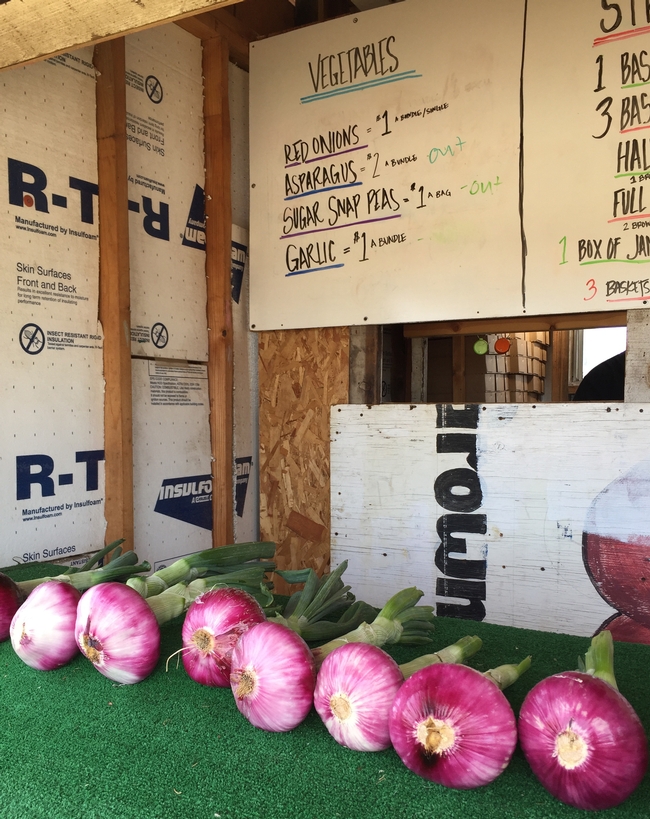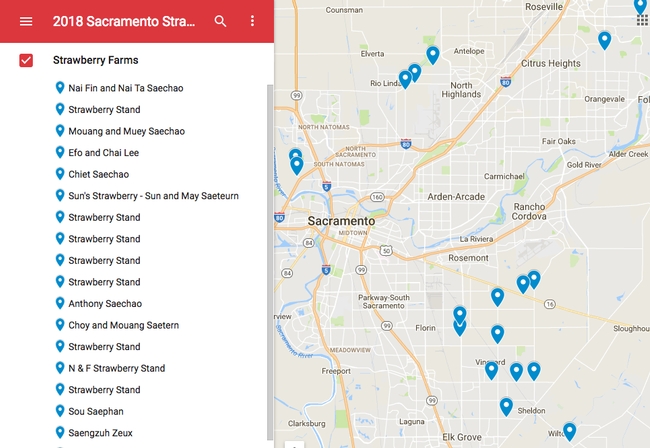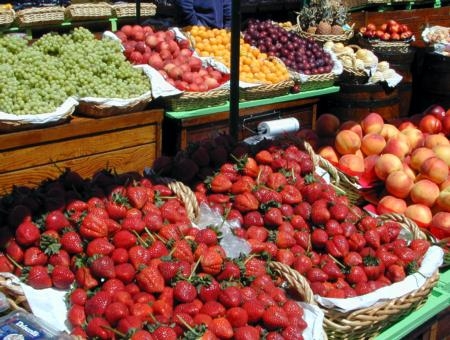Posts Tagged: strawberries
Pectin is not gelatin
If you only have time to read this much: pectin is vegan-friendly.
I was having lunch at an outdoor venue with a lovely vegetarian friend. When we got around to all things canning, I told her how excited I was to try a sugar-free jam recipe using a particular pectin. "I cannot eat jams with pectin. I'm vegetarian," she mentioned. I was shocked. Having a smartphone, I immediately looked up the pectin in question. It's 100% plant-based. I showed her the ingredients, and she was surprised. She thought pectin and gelatin were similar and not vegetarian- or vegan-friendly. If my lovely, smart vegetarian friend was confused by pectin, I suspected others are, too.
Pectin is a thread-like vegetable-based carbohydrate that, when cooked, creates a cross-bond to form a gel. We endorse no products in the UC Master Food Preserver program, so the pectin brand I'm about to reference is for information only.
The pectin I looked up was Pomona's Universal Pectin®. According to their website, it is 100% citrus pectin. The pectin is extracted from the dried peel of lemon, lime and orange after the fruit has been juiced and the oil has been pressed out of the peel. The product is vegan, gluten-free and GMO-free. This particular brand of pectin is set using calcium water; instructions are included in the package. With Sure-Jell Powdered Pectin® and Ball Powdered Pectin®, the ingredients are dextrose, citric acid (assists gel) and fruit pectin.
Commercially packaged pectin comes in liquid or powdered form. Each type has particular uses and cannot be substituted for each other. Recipes typically call out what type of pectin to use and how to use it. Here is an example of a jam using powdered pectin from the UC ANR (University of California Agriculture and Natural Resources) Recipe Library:
Strawberry Jam, using powdered pectin: https://ucanr.edu/sites/camasterfoodpreservers/files/334998.pdf
If Solano/Yolo is your local county, contact us online by following this link: https://surveys.ucanr.edu/survey.cfm?surveynumber=30140.
Happy canning!
For more information about the UC Master Food Preserver Program, including the Food Preservation Video Library, visit mfp.ucanr.edu.
UC explores alternatives to fumigants for strawberries
Strawberries, which generated $2.2 billion for California growers mainly on the coast in 2019, are sensitive to soilborne diseases. Strawberry plant roots infected by fungi are unable to take in nutrients and water, causing the leaves and stems to wilt. The diseases reduce fruit yields and eventually kill infected plants.
To protect the delicate plants from pathogens, strawberry growers fumigate the soil with pesticides such as chloropicrin and 1,3-dichloropropene before planting transplants. Due to the potential negative effects on the environment and human health, however, use of fumigants are highly regulated and developing non-fumigant alternatives has been a priority of the strawberry industry.
For a biological alternative to manage soilborne diseases in strawberries, Joji Muramoto, UC Cooperative Extension organic production specialist based at UC Santa Cruz, has received a $411,395 grant from USDA National Institute of Food and Agriculture to study the ability of other crops to suppress strawberry pathogens in the soil.
Verticillium wilt, caused by Verticillium dahliae, is a common soilborne disease that can be controlled with anaerobic soil disinfestation (ASD), a fermentation-based biological treatment using carbon sources such as rice bran under plastic mulch in moist soils for 3 to 5 weeks in autumn. About 2,000 acres of berry fields, mostly organic, were treated with ASD in California and Baja California, Mexico, in 2019.
In 2008-09, the diseases fusarium wilt, caused by Fusarium oxysporum f. sp. fragariae, and charcoal rot, caused by Macrophomina phaseolina, emerged in Southern California and now threaten strawberry plants throughout the state.
ASD isn't as effective against F. oxysporum and M. phaseolina unless it is applied in summer on the coast. As saprophytes, they feed not only on living plants, but also can colonize crop residues and rice bran especially at lower coastal temperatures in autumn. Treating fields on California's coast with ASD during summer is difficult because it competes with the vegetable production period.
Based on promising studies in Asia and other areas, Muramoto plans to test alliums – such as onion, bunch onion and leek – and a certain variety of wheat (Summit 515) to see if they will suppress F. oxysporum and M. phaseolina. His team will conduct a series of greenhouse and field trials and test these crops with and without ASD to compare the effects on soilborne pathogens.
“Studies have shown the potential of using allium crops to control Fusarium wilt, and Summit 515 wheat for charcoal rot,” Muramoto said. “Our goal is to examine the effectiveness of suppressive crops, optimize them for California strawberry production systems, and evaluate their economic feasibility for commercial use.”
“No single tactic is likely to replace fumigants,” he said. “Integration of multiple biological approaches such as crop rotation, ASD, and use of resistant strawberry varieties is a key to develop a successful non-fumigant-based soilborne disease management strategy for strawberries. This project is a part of such broader efforts.”
At the end of the three-year study, he plans to share the results at workshops, field days and webinars.
Rachael Goodhue, UC Davis professor of agricultural economics; Carol Shennan, UC Santa Cruz professor of environmental studies; and Peter Henry, USDA Agricultural Research Service plant pathologist, are co-principal investigators on the study with Muramoto.
Also collaborating on the project are Christopher Greer, UC Cooperative Extension integrated pest management area advisor in San Luis Obispo County; Oleg Daugovish, UCCE vegetable and strawberry advisor in Ventura County; Mark Bolda, UCCE director strawberry and cane berry advisor in Santa Cruz County; Jan Perez, food systems specialist, and Darryl Wong, farm research manager, at UC Santa Cruz Center for Agroecology and Sustainable Food Systems; Miguel Ramos of Ramos Farm; Agriculture and Land-Based Association (ALBA); Driscoll's; Naturipe; and The Oppenheimer Group.
Roadside strawberry stands offer particularly flavorful fruit
Central Valley residents from Visalia to Sacramento look forward every year to the beginning of strawberry season in early April, when roadside strawberry stands operated by Hmong and Mien farmers open to the public.
These farms grow strawberry varieties such as Chandler and Camarosa that haven't traded flavor for shelf life – they don't ship or store well, but they are far sweeter than varieties usually sold in stores, and they reach their peak ripeness and flavor in the fields next to the strawberry stands.
As strawberry season opens this year, farmers are hoping that customers will still stop by the stands to pick up their fresh, seasonal strawberries, and also that they will observe 6-foot social distancing and other guidelines to reduce the spread of COVID-19. UC Cooperative Extension agricultural assistant Michael Yang and I were interviewed on a local news station to encourage Fresno residents to practice these guidelines while supporting local farmers.
To assist Fresno strawberry farmers, the UCCE small farms team in Fresno County developed, printed, and distributed signs for roadside strawberry stands reminding customers to observe social distancing and other safety practices, as well as guidelines for farm stands to reduce the spread of COVID-19. Versions of the signs were also developed for strawberry stands in Merced and Sacramento, as well as a general sign for local produce at any farm stand.
Signs and safety guidelines were printed with funding from the Western Extension Risk Management Education Center, and Michael Yang distributed large printed versions of the signs to all strawberry stands on the Fresno County Fruit Trail map in Fresno County. These materials have also been shared with UCCE small farms and food systems advisors as well as nonprofit and agency partners and county Agricultural Commissioner's offices, and they are available for printing on the UCCE Fresno strawberry website.
Strawberry stands sell berries fresh from the field
Slugs, snails, ants, aphids, spider mites and inclement weather conspire against strawberry growers harvesting perfect red berries to sell.
“Farming is hard work,” said Fam Lee, as she pulled a weed from a row of strawberry plants. Lee and her husband Nathan Punh are among about 60 Mien farmers in the Sacramento area who call on Margaret Lloyd, a UC Cooperative Extension advisor, for farming advice.
“Although we are not organic farmers, we always want to go with organic,” said Lee. “For example, we have slugs and ants, I asked Margaret if it's okay to put organic slug bait around the plant as long as it doesn't touch the berry. She said that's the best way to do. We work closely with our extension staff.”
In the Sacramento area, many of the Mien-owned farms are husband and wife teams. The typical couple farms an acre or two themselves, picking berries to sell the same day at a roadside stand, which provides the family's primary source of income.
“Many of them grew up on farms in Thailand or Laos growing vegetables or growing rice or soybeans,” said Lloyd, who serves small-scale farmers in Sacramento, Solano and Yolo counties. “A lot of them come from farming backgrounds so when they came to this country, they also sought out an agrarian lifestyle.”
Some Mien growers had never seen a strawberry before arriving in California, but chose the high-value crop to maximize returns on their small plots of land.
To help Mien growers develop successful strawberry farms, Lloyd updates them on regulations and shares growing tips at an annual extension meeting, visits them at their farms, and records videos demonstrating how to do things such as using compost to fertilize the crop.
“Because of language barriers, coming out to the farm regularly is a big part of the job,” said Lloyd, who partners with staff from the National Center for Appropriate Technology (NCAT) to assist Mien farmers.
“Once we're on the farm, we can communicate in-person more easily,” she said. “Often times it involves pest identification, so I'll show them how to use a hand lens and how to identify spider mites, aphids and lygus bugs, for example.”
“A lot of them have children who speak English fluently so if they don't speak English fluently, sometimes the children come out and help.”
For the past five years, Lee and Punh have been growing and selling strawberries at a farm stand on Bond Road, between Bader and Bradshaw, in Sacramento. They grow Albion, Chandler, Santa Rosa and Seascape – sweet, delicate varieties, some of which aren't found in supermarkets because the berries don't store and ship as well. They typically begin harvesting berries at the end of March and pick through July or August, depending on the weather. This year, the first berries were ruined by spring rain and frost.
Savvy consumers will ask for certain varieties by name, Lloyd said. “Chandler is well-loved by consumers for its delicate flesh and sweet flavor. Albion produces larger berries that are also very tasty.”
Because berries sold at the roadside stands are picked fresh daily, the farmers wait until berries are perfectly ripe before picking them.
Monday through Saturday, Lee begins harvesting her strawberries by hand at the break of dawn.
“We start at 5:45, the minute we can see, and we pick until 8 o'clock. That's our goal,” Lee said. “By 8:30, we want to open our stand and we sell until all the berries run out.”
Lee's parents often drive up from Alameda to help pick berries.
To extend the farm stand season, some Mien farmers supplement the strawberries with other berries, strawberry jam and vegetables. They grow blueberries and blackberries, tomatoes, peppers and green beans and sometimes specialty vegetables such as bittermelon.
“Growing strawberries isn't easy, but it's enjoyable work,” Lee said.
Lloyd has updated a map showing locations of about 60 strawberry stands in the Sacramento area at http://bit.ly/strawberrystands.
California drought and the fate of the state’s beloved berries
Will berries taste like colored Styrofoam if water supplies for farmers are cut? Or will a reduction in irrigation only intensify their flavor?
To find out, farm advisors around the state are comparing strawberries, blueberries and blackberries grown under four irrigation regimes – one that reflects the normal practice, one half the normal amount of water, one 75 percent of normal, and one that is 25 percent more than normal. The studies are being conducted in Santa Clara, San Luis Obispo, San Diego and Fresno counties.
“We’re doing this because of the water issue in California,” said Richard Molinar, UC Cooperative Extension advisor in Fresno County. “We’re in drought mode. We want to look at ways farmers can cut back the amount of water they are using and still have good tasting berries.”
Molinar recently brought samples of strawberries grown at the UC Kearney Agricultural Research and Extension Center in Parlier to the Vineyard Farmers Market in Fresno and invited patrons to share their preferences. Strawberry tasters were asked to evaluate the fruits’ appearance, flavor and texture. The advisors will aggregate information from taste testing done on berries from all the research sites.
The research will go beyond consumers’ preferences. Beth Mitcham, UCCE specialist in the Department of Plant Sciences at UC Davis, will evaluate the fruit grown under different irrigation regimes in the laboratory. Mitcham’s research will determine the amount of sugar, the sugar-acid ratio and the amount of antioxidants in the fruit and how these are affected by increasing or decreasing the usual amount of irrigation water.
The study is funded with a specialty crops grant from the California Department of Food and Agriculture awarded to the small farm program under the direction of Shermain Hardesty, UC Cooperative Extension specialist in the Department of Agricultural and Resource Economics at UC Davis.
See video of the strawberry tasting here:


